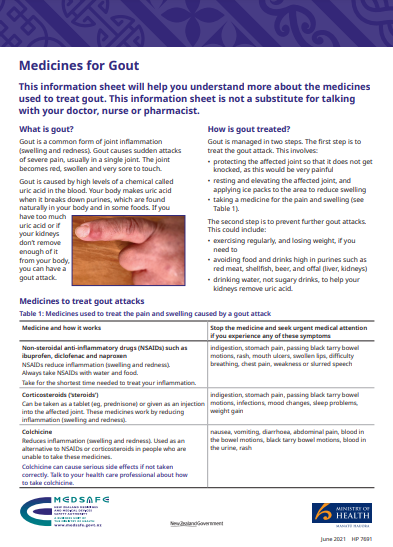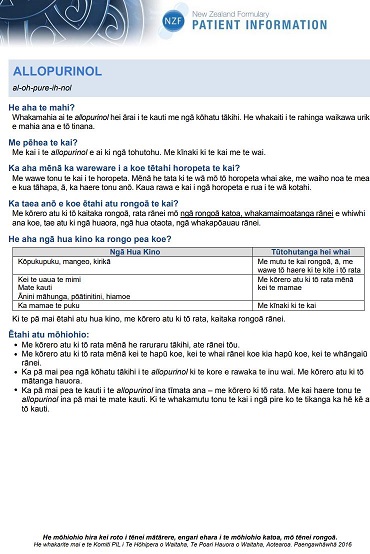Wishing everyone a safe and happy Christmas and New Year – Meri Kirihimete from the Healthify team.
Allopurinol
Sounds like 'al-lo-pew-ri-nol'
Key points about allopurinol
- Allopurinol is a long-term treatment to prevent gout attacks.
- When taken every day, allopurinol stops gout attacks and prevents long-term damage to your joints.

Allopurinol is mainly used as a long-term daily treatment to prevent gout attacks or flares. It helps to prevent permanent damage to your joints.
Allopurinol can also be used to prevent some types of kidney stones and may be used in people receiving cancer chemotherapy, to prevent high uric acid that can occur with some types of chemotherapy.
- Allopurinol reduces the amount of uric acid your body makes. Uric acid is produced in your body when you digest and metabolise some types of food and drinks.
- Usually excess uric acid is passed out in urine, but when uric acid levels are too high, the extra uric acid can turn into crystals in your joints, causing pain and swelling. This is known as gout.
- With ongoing high uric acid levels, the size and number of crystals grow and can sometimes be seen as lumps under the skin (tophi). Over time this can damage your joints, bones and kidneys.
To reduce gout attacks, it's important to keep your uric acid level below 0.36 mmol/L
- When your uric acid is below 0.36 mmol/L, no new crystals can form and crystals that are already in your joints can start to dissolve.
- The risk of gout attacks and joint damage is reduced.
- If you already have tophi, the goal is to get to a uric acid level below 0.3 mmol/L.
- Uric acid levels can be checked with a blood test, which can be done at a blood lab, at your doctors clinic or at some pharmacies.
Factsheet: Allopurinol for gout

Allopurinol for gout factsheet
Healthify He Puna Waiora and Pharmac, NZ, 2024
English [PDF, 175 KB], te reo Māori [PDF, 284 KB], Samoan [PDF, 332 KB], Tongan [PDF, 478 KB]
Video: Deciding to take allopurinol for gout
(Health Navigator Charitable Trust, NZ, 2023)
Video: Starting on allopurinol for gout
(Health Navigator Charitable Trust, NZ, 2023)
In Aotearoa New Zealand allopurinol is available as 100 mg and 300 mg tablets.
- Always take your allopurinol exactly as your doctor has told you. The pharmacy label on your medicine will tell you how much to take, how often to take it, and any special instructions. Know what dose you should be taking. If you are unsure, talk to your pharmacist.
- The dose of allopurinol will be different for different people.
- Your doctor will usually start you on a low dose (usually 50 or 100 mg each day) and increase it very slowly over a few months.
- They will measure your uric acid level with a blood test and increase the allopurinol dose as much as needed until your uric acid level is less than 0.36 mmol/L.
- It can take 6 to 12 months of taking allopurinol every day to get your level to less than 0.36 mmol/L.
- The usual long-term dose of allopurinol is 100 to 600 mg a day. Some people may need up to 900 mg daily.
You can use the following plan to help keep track of your allopurinol as you increase your daily dose.
My dose is:
| Week | Dose |
| week beginning: | |
| week beginning: | |
| week beginning: | |
| week beginning: |
|
| Notes: |
|
- Timing: Take allopurinol once a day with a full glass of water. If you think allopurinol is causing stomach upset, try taking it with food. If you're taking more than 300 mg per day, you may wish to divide the dose and take it twice a day. Talk to your doctor about this
- Drink plenty of water: It's important to drink plenty of water while you're taking allopurinol because kidney stones can develop if you don't drink enough fluid.
- Missed dose: If you forget to take your dose of allopurinol, take it as soon as you remember. But if it's nearly time for your next dose, just take the next dose at the right time. Don't take double the dose.
- Keep taking allopurinol every day, even during a gout attack: If you stop taking it, even for a few days, your uric acid levels will rise and crystals will start to form. This can cause a gout attack and joint damage. Allopurinol is a long-term medicine – you'll probably need to take allopurinol for the rest of your life.
You may have gout attacks when starting allopurinol
You may have gout attacks in the first few months as you're increasing your dose of allopurinol. If this happens, it may feel like your gout is getting worse, but it’s not. As allopurinol reduces the amount of uric acid your body makes, some of the crystals in your joints dissolve. As the crystals dissolve, they can cause a gout attack.
- To manage this, when you start allopurinol, your doctor will prescribe preventative medication such as colchicine, non-steroidal anti-inflammatory drugs (NSAIDs) or prednisone. It's important to take this regularly, for up to 6 months, while you are starting allopurinol.
- Keep taking allopurinol every day, even during a gout attack.
- As your uric acid level decreases over time you're less likely to get gout flares.
- Keeping your uric acid level below 0.36 mmol/L, will help stop your gout attacks. This may take 6 to 12 months of taking allopurinol every day.
Blood tests
When you first start taking allopurinol, you'll need to have blood tests to monitor your uric acid levels every 4 weeks until the target uric acid level has been reached. Then you'll need blood tests every 3 to 6 months to check your uric acid level and your kidney function. This can be done either at the blood lab, your doctors clinic or at some pharmacies.
Here are some things to know when you're taking allopurinol. Other things may be important as well, so ask your healthcare provider what you should know about.
- Skin rash: You may get a skin rash or itching (about 2 in every 100 people who take allopurinol will have a skin rash). This can happen anytime while taking allopurinol, but especially in the first few months while your dose is being increased. If this happens, stop taking allopurinol and contact your doctor immediately – even if the rash is mild. This can develop into a severe allergic reaction.
- Other medicines: Allopurinol may interact with other some other medicines, herbal supplements and Rongoā Māori, so check with your doctor or pharmacist before starting allopurinol and before starting any new products.
- If I'm having a gout attack, will an extra dose of allopurinol help? No. Allopurinol is not a pain relief medicine. If you have an attack of gout while taking allopurinol, keep taking it at the same dose. Don't stop taking it. Your doctor will advise you to take a pain relief medicine, eg, NSAIDs (ibuprofen, diclofenac, naproxen), or prednisone or colchicine. You can also apply ice-packs and rest the painful joint to reduce pain. See your doctor if the pain and inflammation doesn't get better in 24 hours.
Like all medicines, allopurinol can cause side effects, although not everyone gets them. Often side effects improve as your body gets used to the new medicine.
| Side effects | What should I do? |
|---|---|
|
|
|
|
|
|
Read more about medicines and side effects and reporting a reaction you think might be a side effect.
The following links have more information on allopurinol.
Gout Guide(external link) Tools and resources to improve gout outcomes Healthify He Puna Waiora, NZ, 2024
Allopurinol(external link) Rheuminfo
Allopurinol(external link) (te reo Māori(external link)) NZ Formulary Patient Information
Medicines for gout(external link) HealthEd, NZ, 2017
A conversation about gout (includes dispelling common myths including gout is a bad drug)(external link) BPAC, NZ
Out with gout [PDF, 1.4 MB] Pharmac, NZ
References
- Allopurinol(external link) NZ Formulary
- Managing gout in primary care – part 1(external link) BPAC, NZ, 2018
- Managing gout in primary care – part 2(external link) BPAC, NZ, 2018
Brochures

Allopurinol for gout factsheet
Healthify He Puna Waiora and Pharmac, NZ, 2024


My Medicines, NZ
Credits: Sandra Ponen, Pharmacist, Healthify He Puna Waiora. Healthify is brought to you by Health Navigator Charitable Trust.
Reviewed by: Angela Lambie, Pharmacist, Auckland.
Last reviewed:





